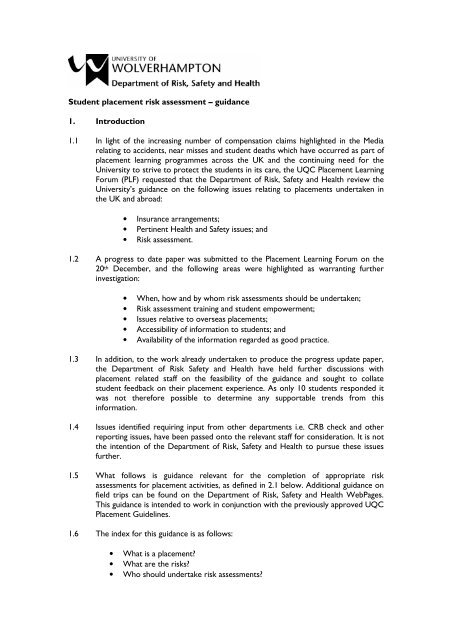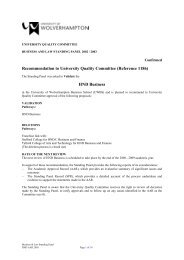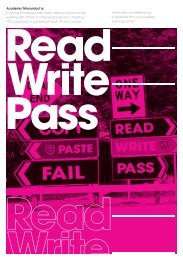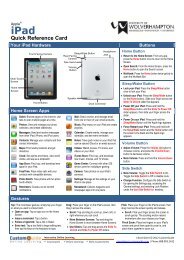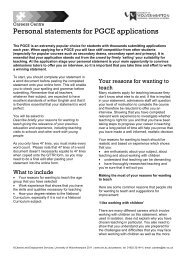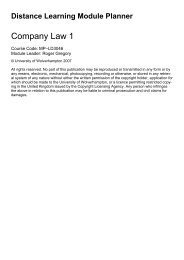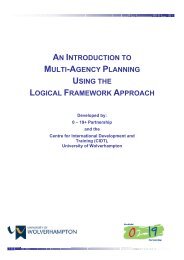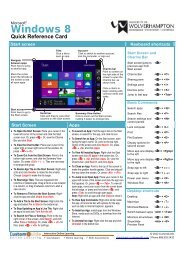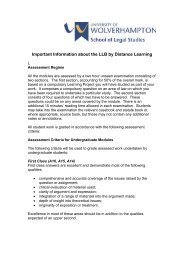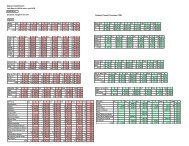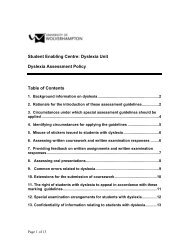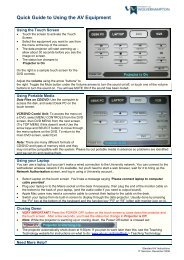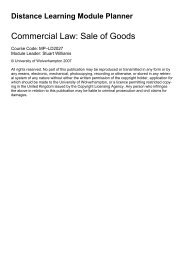Student placement risk assessment - University of Wolverhampton
Student placement risk assessment - University of Wolverhampton
Student placement risk assessment - University of Wolverhampton
- No tags were found...
You also want an ePaper? Increase the reach of your titles
YUMPU automatically turns print PDFs into web optimized ePapers that Google loves.
<strong>Student</strong> <strong>placement</strong> <strong>risk</strong> <strong>assessment</strong> – guidance1. Introduction1.1 In light <strong>of</strong> the increasing number <strong>of</strong> compensation claims highlighted in the Mediarelating to accidents, near misses and student deaths which have occurred as part <strong>of</strong><strong>placement</strong> learning programmes across the UK and the continuing need for the<strong>University</strong> to strive to protect the students in its care, the UQC Placement LearningForum (PLF) requested that the Department <strong>of</strong> Risk, Safety and Health review the<strong>University</strong>’s guidance on the following issues relating to <strong>placement</strong>s undertaken inthe UK and abroad:• Insurance arrangements;• Pertinent Health and Safety issues; and• Risk <strong>assessment</strong>.1.2 A progress to date paper was submitted to the Placement Learning Forum on the20 th December, and the following areas were highlighted as warranting furtherinvestigation:• When, how and by whom <strong>risk</strong> <strong>assessment</strong>s should be undertaken;• Risk <strong>assessment</strong> training and student empowerment;• Issues relative to overseas <strong>placement</strong>s;• Accessibility <strong>of</strong> information to students; and• Availability <strong>of</strong> the information regarded as good practice.1.3 In addition, to the work already undertaken to produce the progress update paper,the Department <strong>of</strong> Risk Safety and Health have held further discussions with<strong>placement</strong> related staff on the feasibility <strong>of</strong> the guidance and sought to collatestudent feedback on their <strong>placement</strong> experience. As only 10 students responded itwas not therefore possible to determine any supportable trends from thisinformation.1.4 Issues identified requiring input from other departments i.e. CRB check and otherreporting issues, have been passed onto the relevant staff for consideration. It is notthe intention <strong>of</strong> the Department <strong>of</strong> Risk, Safety and Health to pursue these issuesfurther.1.5 What follows is guidance relevant for the completion <strong>of</strong> appropriate <strong>risk</strong><strong>assessment</strong>s for <strong>placement</strong> activities, as defined in 2.1 below. Additional guidance onfield trips can be found on the Department <strong>of</strong> Risk, Safety and Health WebPages.This guidance is intended to work in conjunction with the previously approved UQCPlacement Guidelines.1.6 The index for this guidance is as follows:• What is a <strong>placement</strong>?• What are the <strong>risk</strong>s?• Who should undertake <strong>risk</strong> <strong>assessment</strong>s?
• Contact details• Insurance• Appendix A Mentor form• Appendix B Workplace Hazard Identification Checklist• Appendix C Contact details form• Appendix D Placement agreement form (Insurance)2. What is a <strong>placement</strong>?2.1 A student <strong>placement</strong> is defined, for the purposes <strong>of</strong> this guidance, as a period <strong>of</strong>vocational experience, paid or unpaid where:• there is the transfer <strong>of</strong> direct supervision <strong>of</strong> a student to a third partyregardless <strong>of</strong> duration;• the <strong>placement</strong> is integral to the individual student's course or is a validatedoption within the course <strong>of</strong> study; and• the student is enrolled at the <strong>University</strong> during the period <strong>of</strong> the <strong>placement</strong>.2.2 Such <strong>placement</strong>s would include organisations associated with healthcare, educationand social work, exchange schemes, EU student mobility schemes, and studentsstudying at another university.2.3 This guidance does not cover:• One <strong>of</strong>f observational visits. For these activities the <strong>University</strong> mustdemonstrate that sufficient guidance on the likely <strong>risk</strong>s <strong>of</strong> the activity and/orlocation has been provided and students should be advised to undertakepersonal <strong>assessment</strong>s <strong>of</strong> the activity and location as part <strong>of</strong> the observation. The<strong>University</strong> should also be in receipt <strong>of</strong> a basic notification from the student <strong>of</strong>the intended location <strong>of</strong> their <strong>placement</strong> prior to the start date; and• Work based learning students enrolled onto part time <strong>University</strong> courses andundertaking the <strong>placement</strong> at their current place <strong>of</strong> employment. In these casesthe employer is responsible for both the <strong>risk</strong> <strong>assessment</strong> and insurancearrangements.3. What are the <strong>risk</strong>s?3.1 The <strong>risk</strong>s associated with student <strong>placement</strong>s can be separated into two categories:• Foreseeable injury or ill-health arising out <strong>of</strong> the undertaking <strong>of</strong> the<strong>placement</strong> provider i.e. failure to provide appropriate safety equipment;and• Foreseeable injury, ill-health or loss to the <strong>placement</strong> student not arisingout <strong>of</strong> the undertaking <strong>of</strong> the <strong>placement</strong> provider but as a consequence<strong>of</strong> the <strong>placement</strong>, i.e. negligent working practices on the part <strong>of</strong> or inrelation to the student <strong>placement</strong>.
3.2 In order to counter, as far as is reasonably practicable, these <strong>risk</strong>s a <strong>risk</strong> <strong>assessment</strong><strong>of</strong> each <strong>placement</strong> provider should be undertaken prior to the commencement <strong>of</strong>any <strong>placement</strong> activity. The type <strong>of</strong> <strong>risk</strong> <strong>assessment</strong> to be undertaken will varydepending on the level <strong>of</strong> <strong>risk</strong> associated with each activity. These are determined ata local level and are typically defined as:3.3 High level <strong>risk</strong> activities. These would include:• Work in a high <strong>risk</strong> environment such as construction, factory, chemicalproduction work, activity undertaken with the Police or emergency services;• Work in high <strong>risk</strong> locations e.g. those countries listed on the Foreign &Commonwealth Office web page under ' advises against all travel to ' and'advises against travel to unless on essential business ', and locations within theUK with known high social unrest;• At small or medium size enterprises where <strong>risk</strong> control may be inadequate, e.g.small wood workshop, small engineering workshop, garage or automotive paintspraying workshops; and• Social or public services areas, e.g. hospitals, or where the work involves visitsto private residences, or self employed small business operators i.e. solicitors.3.4 It is anticipated that these <strong>placement</strong>s would be for an extended period, i.e. fullacademic year, although they can be <strong>of</strong> any length.3.5 Assessment would comprise 3 stages:• Detailed <strong>risk</strong> <strong>assessment</strong>;• Workplace Hazard Identification Checklist (Appendix B); and• <strong>Student</strong> feedback and <strong>assessment</strong> during and at the end <strong>of</strong> the <strong>placement</strong>.3.6 Medium Level Risk Activity. This would normally apply to:• Organisations which have areas <strong>of</strong> high <strong>risk</strong> associated with their activity but<strong>placement</strong> student not expected work in those areas e.g. production lines; and• Organisations which have undertaken Governmental type <strong>risk</strong> <strong>assessment</strong>s priorto use by the <strong>University</strong> i.e. Schools/Colleges registered through the BritishCouncil, BUNAC and licensed Outward Bound Centres.3.7 These <strong>placement</strong>s would be expected to vary in duration and would encompass asignificant number <strong>of</strong> the <strong>placement</strong>s that the <strong>University</strong> would undertake usuallywithin specific disciplines.
3.8 Assessment would also comprise three stages:• Verification <strong>of</strong> any detailed <strong>risk</strong> <strong>assessment</strong> undertaken, confirmation <strong>of</strong> dateundertaken and assurance that it was undertaken by an appropriately qualifiedmentor, trainer, coach (a form for this purpose is shown as Appendix A), licencearrangements for Outward Bound Centres would also need to assessed at thisstage;• Workplace Hazard Identification Checklist; and• <strong>Student</strong> feedback and <strong>assessment</strong> during and at the end <strong>of</strong> the <strong>placement</strong>.3.9 Low Level Risk Activity. Low-level <strong>risk</strong> activity <strong>placement</strong>s would be <strong>of</strong>fice, orsimilar, based and would involve controlled contact with either high-<strong>risk</strong> equipment,or chemicals. These activities would account for the majority <strong>of</strong> <strong>placement</strong>sundertaken by the <strong>University</strong> and these can vary in duration.3.10 Assessment would comprise <strong>of</strong> 2 stages:• Workplace Hazard Identification Checklist; and• <strong>Student</strong> feedback and <strong>assessment</strong> during and at the end <strong>of</strong> the <strong>placement</strong>.4. Who should undertake <strong>risk</strong> <strong>assessment</strong>s?4.1 Assessment <strong>of</strong> high and medium level <strong>risk</strong> activities can be undertaken using thegeneral <strong>risk</strong> <strong>assessment</strong> form and guidance to be found on the Department <strong>of</strong> Risk,Safety and Health WebPages. Undertaking this level <strong>of</strong> <strong>assessment</strong> will requirespecific <strong>risk</strong> <strong>assessment</strong> training, which is provided by the Department <strong>of</strong> Risk, Safetyand Health and staff can book to attend these sessions via the Corporate StaffDevelopment training programme. Should further guidance/assistance be required inthe case <strong>of</strong> more lengthy, complicated or compliance with <strong>risk</strong> <strong>assessment</strong>s then thiscan be sought from the Department <strong>of</strong> Risk, Safety and Health, who can becontacted on extension 1265.4.2 For low level <strong>risk</strong> activities, and in conjunction with the more detailed <strong>risk</strong><strong>assessment</strong>s for high and medium level <strong>risk</strong> activities, the hazard identificationchecklist appended to this report as Appendix B, should be used.4.3 This checklist covers the key aspects <strong>of</strong> a Health and Safety <strong>risk</strong> <strong>assessment</strong> andgives a reasonable assurance that the environment being assessed is a safe one, andcan therefore be completed by anyone with a general level <strong>of</strong> understanding <strong>of</strong>Health and Safety issues. For high and medium level <strong>risk</strong> activities this should be acompetent member <strong>of</strong> School (academic or administrative) staff, but for low level<strong>risk</strong> activities students themselves can complete the checklist, once they haveundertaken some form <strong>of</strong> School based training.
4.4 In many cases empowering the students to undertake the <strong>risk</strong> <strong>assessment</strong> <strong>of</strong> their<strong>placement</strong> area can enhance the learning experience, and services students with anadditional life long skill. There are several methods, which may be adapted to enablethe provision <strong>of</strong> sufficient Health and Safety guidance to students to enable them toundertake appropriate levels <strong>of</strong> <strong>assessment</strong>, and each School should assess locallythe most effective means by which this can be undertaken. Options which could beconsidered are:• Links from E:vision to a supported site incorporating relevant informationand documentation;• Folder access on WOLF incorporating relevant information anddocumentation; and• Inclusion <strong>of</strong> relevant information and documentation in Induction packs,<strong>placement</strong> packs other student documentation.4.7 The hazard identification checklist includes information on insurance and a generalview <strong>of</strong> DDA requirements however more detailed guidance on these issues shouldbe sought, respectively, from the <strong>University</strong> Insurance Officer, refer to section 6 forcontact details, and from the <strong>Student</strong> Enabling Centre, who have already draftedguidance on this subject (Draft Good Practice Guidance relating to Placements forDisabled <strong>Student</strong>s).5. Emergency arrangements and contact details5.1 Prior to any <strong>placement</strong> being undertaken the <strong>University</strong> must ensure that theinformation it holds in respect <strong>of</strong> the details listed below is accurate:• Home address and telephone number for the student;• Next <strong>of</strong> kin address and telephone number;• Destination, duration and nature <strong>of</strong> the <strong>placement</strong>; and• Placement primary contact details.5.2 An example <strong>of</strong> the kind <strong>of</strong> form which could be completed, in order to gather thisinformation prior to <strong>placement</strong> taking place is shown in Appendix C.5.3 <strong>Student</strong> personal information (address, telephone and next <strong>of</strong> kin details) shouldalready be held on the <strong>Student</strong> Management System (SITS), and students shouldtherefore be requested to check that the personal information held is correct priorto the commencement <strong>of</strong> their <strong>placement</strong> activity. Where discrepancies areidentified the student should be requested to update their details on SITS viaE:vision.5.4 <strong>Student</strong>s also be advised to share any medical conditions or concerns with the dutyfirst aider at the <strong>placement</strong> location and/ or wear a medi-alert tag. The <strong>University</strong>cannot however force students to undertake either <strong>of</strong> these actions nor can it insistthat medical conditions are declared at any stage <strong>of</strong> the student cycle. In most casesstudents with serious conditions are fully aware <strong>of</strong> the corrective actions requiredshould their condition(s) be triggered or worsen and are fully prepared for dealingwith their own emergencies.
5.5 Contingency arrangements should be developed, in order to ensure, that in theevent that students have to be brought back home (if the <strong>placement</strong> is abroad) orthey have to terminate the <strong>placement</strong> in the event <strong>of</strong> a reportable incident, i.e. majorinjuries or incidents leading to serious illness, hospitalisation, or death, this could beaffected swiftly.6. Insurance6.1 Placement students should be covered under the <strong>placement</strong> provider’s EmployersLiability Insurance in the same manner as the provider would cover their ownemployees. In this regard the student should be classed as an employee.6.2 The <strong>University</strong>'s own Public Liability Insurance would come in to force if the:• UK based <strong>placement</strong> provider is a company with less than 5 employees, and istherefore exempt from the requirement to hold its own Employers LiabilityInsurance, where this is the case a full <strong>risk</strong> <strong>assessment</strong> will need to beundertaken by the <strong>University</strong> prior to any <strong>placement</strong>s taking place; or• student on <strong>placement</strong>, within the UK, does damage to third party property orpersons in the course <strong>of</strong> that <strong>placement</strong>, and the 3 rd party wishes to pursue the<strong>University</strong> for compensation, i.e. the <strong>placement</strong> student uses the wrong acetatein a photocopier and causes damage, the <strong>placement</strong> provider may then wish topursue the <strong>University</strong> for compensation in respect <strong>of</strong> the damaged photocopier.6.3 Each <strong>placement</strong> provider should be requested to submit details <strong>of</strong> their Employersand Public Liability Insurance policies and confirm the inclusion <strong>of</strong> the <strong>placement</strong>students on it. This should be done on the <strong>Student</strong> Placement Agreement(Insurance) Form (Ref: FNC/TECH/1369), which is available to download from theFinance Department web site. This form should be issued before the student takesup their <strong>placement</strong>. A copy is attached for reference as Appendix D.6.4 In the event that a returned form indicates that there is no insurance cover, pleasecontact the Insurance Officer to discuss the matter prior to <strong>placement</strong> taking place.Contact details for the <strong>University</strong> Insurance Officer, Martyn Jones, are as follows:Telephone extension: 1301 or Email M.A.Jones@wlv.ac.uk6.5 Where students are expected to drive as part <strong>of</strong> their <strong>placement</strong> then their ownvehicle insurance should be amended to reflect the requirement. The <strong>University</strong> isnot liable for cover in this area. Similarly where students are taken out in Companyvehicles, the provider is liable for insurance cover not the <strong>University</strong>.Risk, Safety and Health2 nd March 2006
Appendix A<strong>Student</strong> Placement - Mentor FormFor completion prior to the commencement <strong>of</strong> any work based learning activityrequiring the student to undertake pr<strong>of</strong>essional training/coachingName <strong>of</strong>student;………………………………………………………………………………………….<strong>Student</strong>number…………………………………………………………………………………………..Location <strong>of</strong><strong>placement</strong>:……………………………………………………………………………………….Duration <strong>of</strong> <strong>placement</strong> (with start and end dates)……………………………………………Mentor name and telephone number………………………………………………………………………………………………………………………………………………………………………………………………………………………………………………………………Mentor experience – years experience………………………………………………………..Mentor experience – relevant qualifications………………………………………………………………………………………………………………………………………………………<strong>Student</strong> home address and telephone number:………………………………………………………………………………………………………………………………………………………………………………………………………………………………………………………………………………………………………Signed(Mentor)………………………………………………………………………………………..Date……………………………………………….
Appendix BWorkplace Hazard Identification ChecklistWorking Conditions1. Are the lighting, heating and ventilation arrangements compliant with WorkplaceRegulations?…………………………………………………………………………………………………2. How frequently are the toilet facilities and hand wash areas cleaned?…………………………………………………………………………………………………3. Are the rest and refectory areas regularly cleaned?…………………………………………………………………………………………………4. Are gangways and stair ways kept clear <strong>of</strong> obstruction?…………………………………………………………………………………………………5. Are out <strong>of</strong> reach storage areas safely managed?…………………………………………………………………………………………………6. Are outside areas cleaned and maintained?…………………………………………………………………………………………………7. What is the smoking policy and is it enforced?…………………………………………………………………………………………………8. Is a lone working policy in operation, if so what is it?…………………………………………………………………………………………………9. Are there adequate access arrangements in place as required under DDA (this questionis to be answered by and for students with mobility impairment only)?…………………………………………………………………………………………………10. Are there any other personal issues which need to be highlighted at this stage?…………………………………………………………………………………………………
3 Fire Precautions11. Has a fire <strong>risk</strong> <strong>assessment</strong> been carried out? If yes, when?…………………………………………………………………………………………………12. Is there a fire certificate, if so what is the date <strong>of</strong> issue?…………………………………………………………………………………………………13. Was training given on the emergency evacuation procedure in operation?…………………………………………………………………………………………………14. Where are the fire assembly points?…………………………………………………………………………………………………15. Where are the fire extinguishers located and what type are they (foam, powder) andhow many <strong>of</strong> them are there?…………………………………………………………………………………………………16. Have you received training on the use <strong>of</strong> fire extinguishers, if so please record the date?…………………………………………………………………………………………………4 First Aid17. Is there a qualified first aider in post?…………………………………………………………………………………………………18. Is their certificate up to date, what is the expiry date?…………………………………………………………………………………………………19. What is the location <strong>of</strong> the nearest first aid box?…………………………………………………………………………………………………5 Accident Procedures20. How are accidents/ near misses reported?…………………………………………………………………………………………………
21. How are RIDDOR incidents routinely reported to HSE?…………………………………………………………………………………………………22. Are designated staff on hand to investigate accidents and take remedial action whererequired?…………………………………………………………………………………………………6 Management and Supervision23. How will the <strong>placement</strong> student be supervised/managed?…………………………………………………………………………………………………24. Which parts <strong>of</strong> the premises are out <strong>of</strong> bounds to the student <strong>placement</strong>?…………………………………………………………………………………………………25. How will the student be advised <strong>of</strong> these?…………………………………………………………………………………………………Health and Safety Policy26. Is there a written Health and Safety policy?…………………………………………………………………………………………………27. Has the student received a copy?…………………………………………………………………………………………………28. Is a Safety Law poster completed and displayed?…………………………………………………………………………………………………7 Personal Protective Equipment29. Is PPE likely to be required during this <strong>placement</strong>?…………………………………………………………………………………………………30. What type and how is it issued and managed?…………………………………………………………………………………………………8 Insurance31. Indicate the type <strong>of</strong> insurance held:• Public Liability;• Employers Liability; or
• Combined Liability.32. Name <strong>of</strong> the Insurance Company…………………………………………………………………………………………………33. Policy Number and expiry date:…………………………………………………………………………………………………34. Does the insurance cover visitors/ non employees?………………………………………………………………………………………………35. Is an Employers Liability certificate displayed, if yes where?…………………………………………………………………………………………………Signed(student)……………………………………………………………………………………….Date…………………………………………………………………………………………..Signed(employer)……………………………………………………………………………………..Date…………………….……………………………………………………………………...
Appendix C<strong>Student</strong> Placement - Personal Data RecordFor completion prior to the commencement <strong>of</strong> any work based learning activityName <strong>of</strong> student;………………………………………………………………………………<strong>Student</strong> number…………………………………………………………………………………Location <strong>of</strong> <strong>placement</strong>:…………………………………………………………………………Duration <strong>of</strong> <strong>placement</strong> (with start and end dates)……………………………………………Placement contact: name and telephone number………………………………………………<strong>Student</strong> home address and telephone number:………………………………………………………………………………………………………………………………………………………………………………………………………………………………………………………………………………………………………This section is for use in an emergency only:Next <strong>of</strong> kin home address and telephone number:………………………………………………………………………………………………………………………………………………………………………………………………………………………………………………………………………………………………………Signed(student)…………………………………………………………………………………………Date………………………………………………


